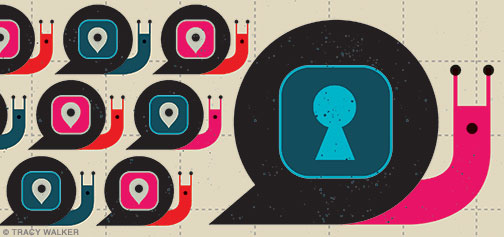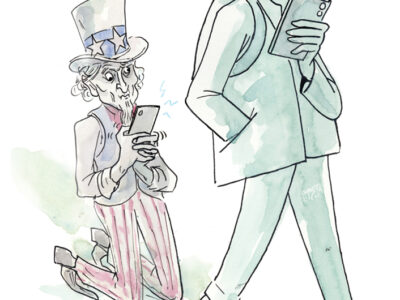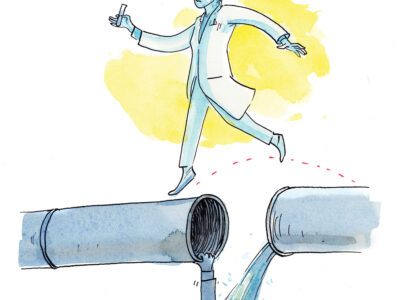
Why ride-sharing apps aren’t the answer to jammed traffic.
By Sam Schwartz | If the goal is to improve mobility for city dwellers—to replace automobile dependency with active and multimodal transportation options—then it’s difficult to see how ride-matching can ever be more than a small part of the solution. That’s because the defining characteristic of the Ubers and Lyfts of the world (and of their very vocal cheerleaders) is hostility to regulation.
For decades now, regulation has been getting very bad press, and not just from conservative politicians and libertarian economists. Everyone has a list of silly bureaucratic rules that have long outlived their usefulness, and I’m no exception. One of my favorites is the requirement that a car’s registration sticker must be to the left of the inspection sticker or you’ll get a ticket. Wait, I think it might be the other way around. Actually, I’m not sure whether it applies when you’re in the car or facing the car. But, after spending a lifetime studying the subject, one of the few unarguably true things I’ve learned about transportation networks is that access to them can’t be efficiently allocated by an unregulated free market.
The first problem with eliminating, or strictly limiting, regulation of these new-and-exciting services is consumer protection. Because ride-matching isn’t a regulated business, the relationship between drivers and riders—all that “sharing”—is governed by contract law.
When you download an app and take a trip in a car you summoned, the contract you accepted is between you and your driver, not with the company that created the app. Uber isn’t responsible, for example, if one of their drivers attacks you, or runs you down. That’s why they insist that the drivers carry liability insurance of $1 million. The company’s terms and conditions include the following:
- Uber does not guarantee the suitability, safety or ability of third party providers. it is solely your responsibility to determine if a third party provider will meet your needs and expectations
- By using the services, you acknowledge that you may be exposed to situations involving third party providers that are potentially unsafe, offensive, harmful to minors, or otherwise objectionable.
- Uber shall not have any liability arising from or in any way related to your transactions or relationship with third party providers.
Uber clearly has no legal exposure whatever. But the real problem with an unregulated market in ride-matching, where the number of smartphone-dispatched cars is limited only by the number of willing drivers, isn’t a lack of liability. It’s a surplus of VIM—Vehicles in Motion.
The VIM problem isn’t a new one—but then, once you strip away the GPS and smartphone apps from ride-matching services, they’re not entirely new either. What they resemble, more than anything else, are old-fashioned radio-dispatched limousines, a subject with which I have some history.
Back in 1982, when the number of taxi medallions in New York City—at that time, 11,787, which was the same number issued in 1937, although since then it’s been allowed to increase to 13,347—seemed inadequate to the demand, a guy named Bill Fugazy, who owned the Fugazy Limousine Company, announced that he was prepared to put 6,000 brand-new limousines on the streets of the city, each of them just a phone call away from anyone with a credit card.
The number actually didn’t sound too daunting. More than 30,000 vehicles enter midtown Manhattan each hour; 200,000 a day. Manhattan’s bridges and tunnels were handling more than 1 million daily. What could be so difficult about handling another 6,000? The mayor was for it. The city council was for it. The voting public was for it. The only people who saw any red flags were cranky transportation engineers. Such as me.
What we knew was this: at that time, the number of vehicles in Manhattan’s Central Business District at any one time was between 139,000 and 181,000. But we also knew that not all of them were actually moving. Many if not most were parked. I figured that the way to calculate the true number of vehicles in motion for any given hour required knowing the miles traveled during that hour, divided by the speed, in miles per hour.
Simple algebra. And simple geometry. Knowing, for example, that the core of Manhattan’s grid comprised segments of 11 avenues, each segment 1.19 miles long, I was able to calculate that, during the morning rush hour, between the hours of 8 and 9 a.m., only a few more than 5,200 vehicles in the core were in motion, and the maximum number that would allow any movement at all was less than 9,000.
Which meant that if only a third of those radio-controlled limos-of-the-future were to operate in the most desirable part of New York at any given time, they would increase traffic density by at least 20 percent. The result? Total gridlock. As I wrote at the time, all those limos would be stopped dead, with their only purpose to provide seating space on Manhattan streets at $25 per hour.
It’s not just a New York problem. Every city on the planet has a measurable VIM maximum. It’s a different number for each city. In Manhattan, it’s a little more than 7,000 cars. Each car above that critical number on the streets results in fewer total miles traveled. Nor is it like an on-off switch. Mobility starts to degrade long before complete gridlock occurs.
This doesn’t mean that there’s no place for ride-matching services in a Street Smart city. Not only are they hugely convenient, they make the decision to live without a personal car possible, even attractive. I applaud the technology that created them, and expect that they will continue to supplant existing taxi companies, or to convert those existing companies to a service that looks a lot like Uber: cabs that can be summoned to a particular location using GPS, and paid for using smartphones. But to the degree that their appeal depends on increasing the supply of cars to the point that no one is ever more than a few minutes away from a roving driver waiting for a smartphone to put driver and rider together, the model is fundamentally unsustainable. Long before enough smartphone-carrying drivers hit the streets, the VIM tipping point will be reached. Beyond that point—that is, beyond the maximum carrying capacity of a particular city’s streets—the numbers won’t add up to more mobility, but less.
This is an unavoidable fact of life. No matter how sophisticated the technology becomes, public streets will remain a public resource with finite capacity. When ride-matching services like Uber and Lyft treat city streets as a free good, they’re just repeating the same conceptual mistake that the original champions of motordom did during the 1920s—the argument that, while streetcars and trains were responsible for maintenance of “their” right-of-way, streets were free for everyone. Smart cities shouldn’t insist on stupid regulation. But that doesn’t mean they can do without regulation at all.
Sam Schwartz GCE’70, a storied New York traffic engineer, is profiled here. Excerpt from STREET SMART: The Rise of Cities and the Fall of Cars by Sam Schwartz. Reprinted with permission from PublicAffairs.




